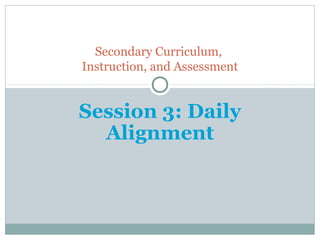
Daily alignment (1)
- 1. Secondary Curriculum, Instruction, and Assessment Session 3: Daily Alignment
- 2. Today’s learning objectives 1. Explain how core standards, objectives, and indicators relate to unit and daily lesson plans. 2. Identify the steps to backward design. 3. Compose learning objectives at all levels of Bloom’s Taxonomy. 4. Align formative assessments with daily indicators.
- 4. Example: Hiroshima Global objective: (empathy) To examine a focal event in American History through the eyes of “the enemy” (to place students in the position of “Other”). State Core/Educational objectives (Unit objectives): 1.2 Comprehend and evaluate informational text. 1.3 Comprehend and compare culturally and historically significant literary forms. 2.1 Evaluate ideas and information to refine thinking through writing.
- 5. Example (cont). (some) Daily Learning objectives (indicators): 1.2b Evaluate the effectiveness of internal text structures in a variety of texts. 1.2c Identify an author’s implicit and stated assumptions about a subject based on the evidence in the text. 1.3d Evaluate the impact of setting and historical context on literary works 2.1a Evaluate the merit of opposing opinions
- 6. Instructional Planning Course Planning General Unit Planning Daily Lesson Planning Specific
- 8. Learning Objective #2: Backward Design What do I want my students to know/do? = determine your objective(s) How will I know when they know and can do it? = design your assessment How do I prepare them to know and do it? = plan your lesson
- 9. Learning Objective #3 (BD step 1) You will be able to compose learning objectives at all levels of Bloom’s (grad students’) cognitive taxonomy. “Learning Objectives” = “Indicators”
- 10. Not: Students will know the Pythagorean theorem. But: Students will apply the Pythagorean theorem to solve problems.
- 11. Not: Students will gain an appreciation for the role of culture in student learning. But: Students will list three assumptions Native American students may hold regarding teacher-student relationships.
- 12. Not: Students will learn about suicide. But: Students will identify five warning signs of suicide.
- 13. Not: Students will understand how important freedom is. But: Students will explain the personal relevance of the first five amendments to the Bill of Rights.
- 14. Characteristics of good learning objectives:
- 15. Why are learning objectives important? They help you . . . Focus your content Select instructional models and strategies Develop and select instructional materials Determine your assessment Demonstrate what you value Keep teaching and learning focused
- 16. Bloom’s Cognitive Taxonomy Creating – generating new ideas, products, or ways of doing things Evaluating – justifying or judging Analyzing – breaking information into parts to determine how it fits together Applying – transferring information to a new context Understanding – explaining ideas or concepts Remembering – recalling information
- 17. Remembering Recalling specific items (e.g. facts, vocabulary) know define memorize repeat record list recognize name recall identify tell recite Recite the Pledge of Allegiance.
- 18. Understanding Grasping the meaning of the material. Restate discuss explain describe express paraphrase illustrate distinguish recognize Reword the Pledge of Allegiance.
- 19. Applying Transferring knowledge to a new context. generalize apply practice relate examine solve describe show criticize Describe how allegiance may be demonstrated by someone’s behavior.
- 20. Analyzing Breaking down material into parts to determine how it fits together. differentiate compare contrast organize classify arrange discriminate distinguish subdivide Distinguish between allegiance to “the flag” and allegiance to “the republic for which it stands.”
- 21. Evaluating Making judgments based on criteria and standards. Justifying a decision or action. judge appraise evaluate value rate critique check choose Decide if the ideas expressed in the Pledge of Allegiance exemplify the behavior of worthy citizens
- 22. Creating Putting elements together to form a coherent whole or new structure. design compose generate make fashion construct initiate invent Create a new Pledge of Allegiance based on original ideas combined with modern paradigms and moralities.
- 24. Comparison Objectives Name the five causes of dizziness. Given a patient case description, determine the three most likely causes of dizziness.
- 25. Comparison objectives Identify melodic and harmonic intervals. Transpose a composition from the key of C Major to the key of F Major.
- 26. Comparison objectives Identify characteristics of a polygon. Given the coordinates, use the Cartesian coordinate system to find the dimensions of a polygon.
- 27. Comparison objectives List the levels of Bloom’s cognitive taxonomy in ascending order. Create measurable indicators for a particular objective based on Bloom’s cognitive taxonomy.
- 28. Indicator #3: Compose learning objectives Select an objective from your core and practice composing learning objectives (aka: indicators) at the Different levels of Bloom’s cognitive taxonomy. Hints: Focus on student performance, not teacher performance Focus on product, not process Include only one learning outcome in each objective Be clear, measurable, realistic, appropriate, and worthy Underline your verb
- 29. Indicator #4: Align formative assessments This is Backward Design step 2! Now go back through those indicators and determine how you would assess student mastery of those indicators. Hints: Indicator + venue Underline your verb Make sure it’s cognitively aligned to your indicator
- 30. Today’s formative assessment! Can you . . . 1. Explain how core standards, objectives, and indicators relate to unit and daily lesson plans. 2. Identify the steps to backward design. 3. Compose learning objectives at all levels of Bloom’s Taxonomy. 4. Align formative assessments with daily indicators.
- 31. For next time: Cognitive Alignment Table – bring hard copy Read “Differentiation – What and Why” (posted on the calendar) Read pp. 263-265, “The Graffiti Model” (part of Chapter 13 in your text)
